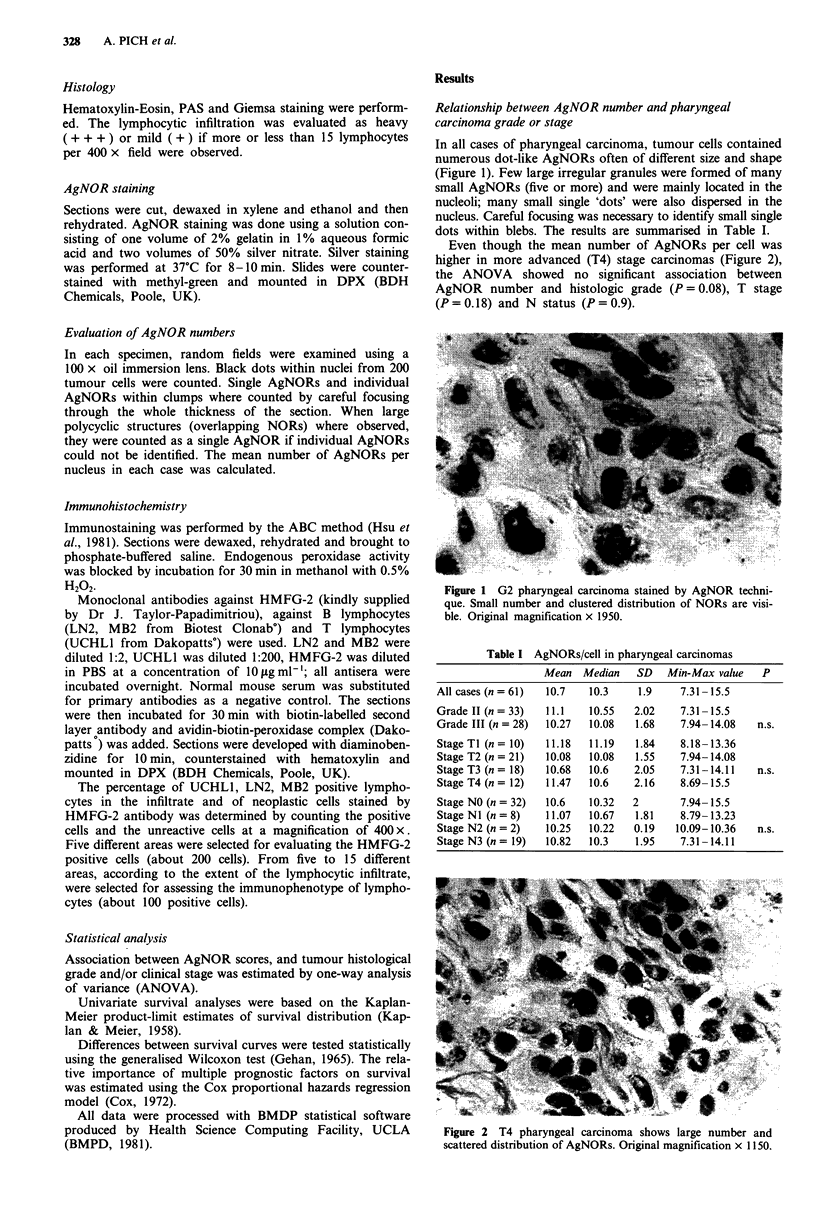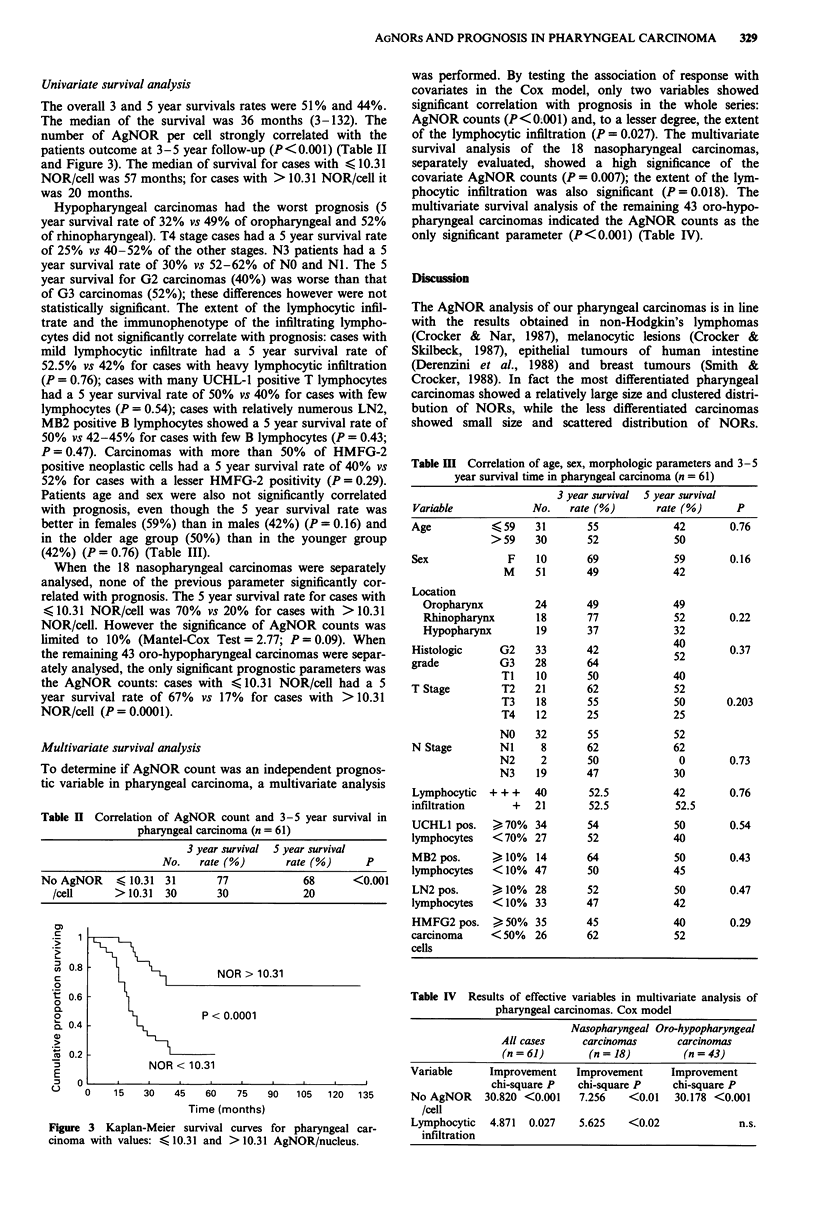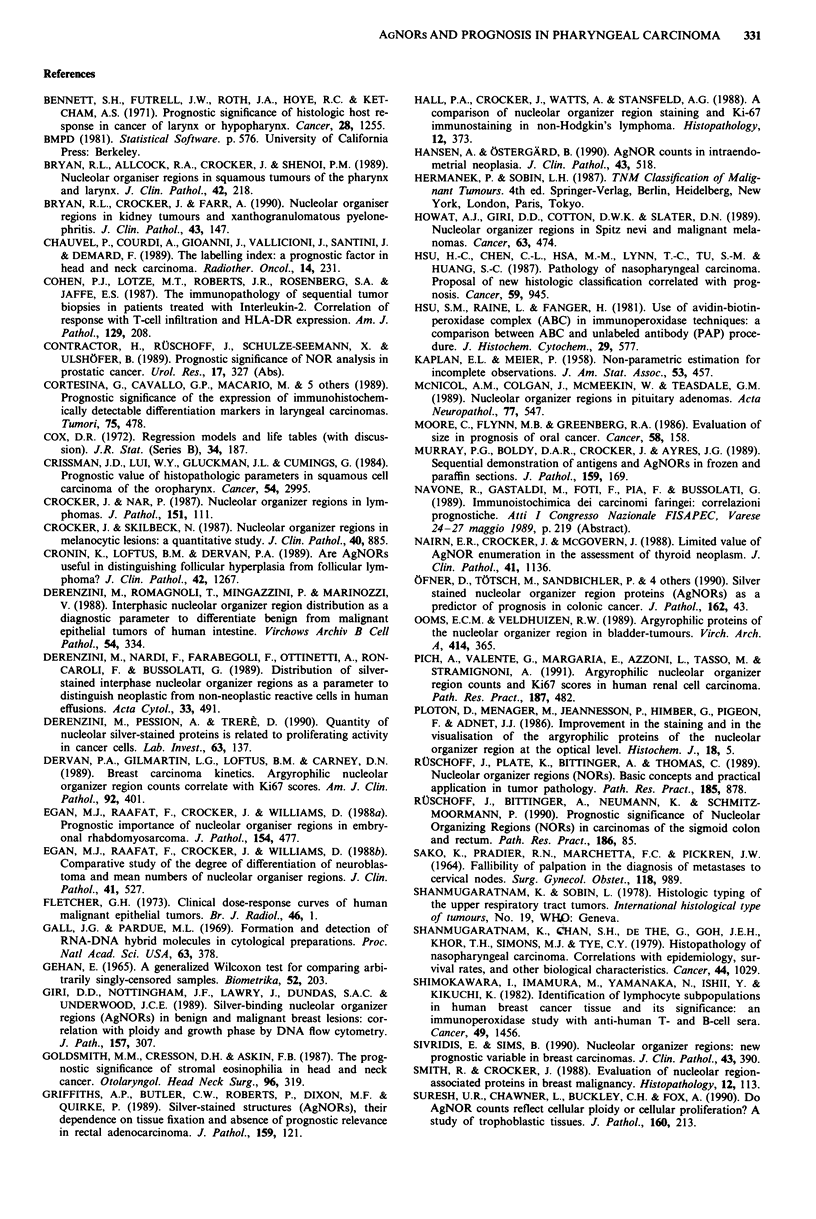Abstract
The prognostic significance of argyrophilic nucleolar organiser regions (AgNORs) has been evaluated in biopsy specimens from 61 primary squamous and undifferentiated carcinomas of the pharynx prior to therapy. The univariate Kaplan-Meyer survival analysis showed a significant correlation between 3- and 5-year survival rates and the mean AgNOR number per tumour cell (P less than 0.001). No significant correlation was found between prognosis and patients age and sex, tumour location, clinical stage, histologic grade, extent of lymphocytic infiltration, HMFG-2 positivity of tumour cells and UCHL1, LN2, MB2 positivity of infiltrating lymphocytes. There was no significant association between AgNOR counts and tumour histologic grade or clinical stage. Multivariate survival analysis showed that only two variables were significantly correlated with prognosis: AgNOR counts (P less than 0.001) and the extent of lymphocytic infiltration (P less than 0.027). Our results indicate the prognostic value of AgNOR counts and suggest the use of this method as a significant parameter in the pretherapeutic assessment of the aggressiveness of pharyngeal carcinomas.
Full text
PDF





Images in this article
Selected References
These references are in PubMed. This may not be the complete list of references from this article.
- Bennett S. H., Futrell J. W., Roth J. A., Hoye R. C., Ketcham A. S. Prognostic significance of histologic host response in cancer of the larynx or hypopharynx. Cancer. 1971 Nov;28(5):1255–1265. doi: 10.1002/1097-0142(1971)28:5<1255::aid-cncr2820280524>3.0.co;2-a. [DOI] [PubMed] [Google Scholar]
- Bryan R. L., Allcock R. A., Crocker J., Shenoi P. M. Nucleolar organiser regions in squamous tumours of the pharynx and larynx. J Clin Pathol. 1989 Feb;42(2):218–218. doi: 10.1136/jcp.42.2.218. [DOI] [PMC free article] [PubMed] [Google Scholar]
- Bryan R. L., Crocker J., Farr A. Nucleolar organiser regions in kidney tumours and xanthogranulomatous pyelonephritis. J Clin Pathol. 1990 Feb;43(2):147–148. doi: 10.1136/jcp.43.2.147. [DOI] [PMC free article] [PubMed] [Google Scholar]
- Chauvel P., Courdi A., Gioanni J., Vallicioni J., Santini J., Demard F. The labelling index: a prognostic factor in head and neck carcinoma. Radiother Oncol. 1989 Mar;14(3):231–237. doi: 10.1016/0167-8140(89)90171-0. [DOI] [PubMed] [Google Scholar]
- Cohen P. J., Lotze M. T., Roberts J. R., Rosenberg S. A., Jaffe E. S. The immunopathology of sequential tumor biopsies in patients treated with interleukin-2. Correlation of response with T-cell infiltration and HLA-DR expression. Am J Pathol. 1987 Nov;129(2):208–216. [PMC free article] [PubMed] [Google Scholar]
- Cortesina G., Cavallo G. P., Macario M., Magnano M., Roncaroli F., Cerrato M., Sapino A., Bussolati G. Prognostic significance of the expression of immunohistochemically detectable differentiation markers in laryngeal carcinomas. Tumori. 1989 Oct 31;75(5):478–482. doi: 10.1177/030089168907500516. [DOI] [PubMed] [Google Scholar]
- Crissman J. D., Liu W. Y., Gluckman J. L., Cummings G. Prognostic value of histopathologic parameters in squamous cell carcinoma of the oropharynx. Cancer. 1984 Dec 15;54(12):2995–3001. doi: 10.1002/1097-0142(19841215)54:12<2995::aid-cncr2820541230>3.0.co;2-r. [DOI] [PubMed] [Google Scholar]
- Crocker J., Nar P. Nucleolar organizer regions in lymphomas. J Pathol. 1987 Feb;151(2):111–118. doi: 10.1002/path.1711510203. [DOI] [PubMed] [Google Scholar]
- Crocker J., Skilbeck N. Nucleolar organiser region associated proteins in cutaneous melanotic lesions: a quantitative study. J Clin Pathol. 1987 Aug;40(8):885–889. doi: 10.1136/jcp.40.8.885. [DOI] [PMC free article] [PubMed] [Google Scholar]
- Cronin K., Loftus B. M., Dervan P. A. Are AgNORs useful in distinguishing follicular hyperplasia from follicular lymphoma? J Clin Pathol. 1989 Dec;42(12):1267–1268. doi: 10.1136/jcp.42.12.1267. [DOI] [PMC free article] [PubMed] [Google Scholar]
- Derenzini M., Nardi F., Farabegoli F., Ottinetti A., Roncaroli F., Bussolati G. Distribution of silver-stained interphase nucleolar organizer regions as a parameter to distinguish neoplastic from nonneoplastic reactive cells in human effusions. Acta Cytol. 1989 Jul-Aug;33(4):491–498. [PubMed] [Google Scholar]
- Derenzini M., Pession A., Trerè D. Quantity of nucleolar silver-stained proteins is related to proliferating activity in cancer cells. Lab Invest. 1990 Jul;63(1):137–140. [PubMed] [Google Scholar]
- Derenzini M., Romagnoli T., Mingazzini P., Marinozzi V. Interphasic nucleolar organizer region distribution as a diagnostic parameter to differentiate benign from malignant epithelial tumors of human intestine. Virchows Arch B Cell Pathol Incl Mol Pathol. 1988;54(6):334–340. doi: 10.1007/BF02899231. [DOI] [PubMed] [Google Scholar]
- Dervan P. A., Gilmartin L. G., Loftus B. M., Carney D. N. Breast carcinoma kinetics. Argyrophilic nucleolar organizer region counts correlate with Ki67 scores. Am J Clin Pathol. 1989 Oct;92(4):401–407. doi: 10.1093/ajcp/92.4.401. [DOI] [PubMed] [Google Scholar]
- Egan M., Raafat F., Crocker J., Williams D. Comparative study of the degree of differentiation of neuroblastoma and mean numbers of nucleolar organiser regions. J Clin Pathol. 1988 May;41(5):527–531. doi: 10.1136/jcp.41.5.527. [DOI] [PMC free article] [PubMed] [Google Scholar]
- Fletcher G. H. Clinical dose-response curves of human malignant epithelial tumours. Br J Radiol. 1973 Jan;46(541):1–12. doi: 10.1259/0007-1285-46-541-1. [DOI] [PubMed] [Google Scholar]
- GEHAN E. A. A GENERALIZED WILCOXON TEST FOR COMPARING ARBITRARILY SINGLY-CENSORED SAMPLES. Biometrika. 1965 Jun;52:203–223. [PubMed] [Google Scholar]
- Gall J. G., Pardue M. L. Formation and detection of RNA-DNA hybrid molecules in cytological preparations. Proc Natl Acad Sci U S A. 1969 Jun;63(2):378–383. doi: 10.1073/pnas.63.2.378. [DOI] [PMC free article] [PubMed] [Google Scholar]
- Giri D. D., Nottingham J. F., Lawry J., Dundas S. A., Underwood J. C. Silver-binding nucleolar organizer regions (AgNORs) in benign and malignant breast lesions: correlations with ploidy and growth phase by DNA flow cytometry. J Pathol. 1989 Apr;157(4):307–313. doi: 10.1002/path.1711570407. [DOI] [PubMed] [Google Scholar]
- Goldsmith M. M., Cresson D. H., Askin F. B. The prognostic significance of stromal eosinophilia in head and neck cancer. Otolaryngol Head Neck Surg. 1987 Apr;96(4):319–324. doi: 10.1177/019459988709600403. [DOI] [PubMed] [Google Scholar]
- Griffiths A. P., Butler C. W., Roberts P., Dixon M. F., Quirke P. Silver-stained structures (AgNORs), their dependence on tissue fixation and absence of prognostic relevance in rectal adenocarcinoma. J Pathol. 1989 Oct;159(2):121–127. doi: 10.1002/path.1711590206. [DOI] [PubMed] [Google Scholar]
- Hall P. A., Crocker J., Watts A., Stansfeld A. G. A comparison of nucleolar organizer region staining and Ki-67 immunostaining in non-Hodgkin's lymphoma. Histopathology. 1988 Apr;12(4):373–381. doi: 10.1111/j.1365-2559.1988.tb01952.x. [DOI] [PubMed] [Google Scholar]
- Hansen A., Ostergård B. AgNOR counts in intraendometrial neoplasia. J Clin Pathol. 1990 Jun;43(6):518–519. doi: 10.1136/jcp.43.6.518-b. [DOI] [PMC free article] [PubMed] [Google Scholar]
- Howat A. J., Giri D. D., Cotton D. W., Slater D. N. Nucleolar organizer regions in Spitz nevi and malignant melanomas. Cancer. 1989 Feb 1;63(3):474–478. doi: 10.1002/1097-0142(19890201)63:3<474::aid-cncr2820630314>3.0.co;2-3. [DOI] [PubMed] [Google Scholar]
- Hsu H. C., Chen C. L., Hsu M. M., Lynn T. C., Tu S. M., Huang S. C. Pathology of nasopharyngeal carcinoma. Proposal of a new histologic classification correlated with prognosis. Cancer. 1987 Mar 1;59(5):945–951. doi: 10.1002/1097-0142(19870301)59:5<945::aid-cncr2820590516>3.0.co;2-b. [DOI] [PubMed] [Google Scholar]
- Hsu S. M., Raine L., Fanger H. Use of avidin-biotin-peroxidase complex (ABC) in immunoperoxidase techniques: a comparison between ABC and unlabeled antibody (PAP) procedures. J Histochem Cytochem. 1981 Apr;29(4):577–580. doi: 10.1177/29.4.6166661. [DOI] [PubMed] [Google Scholar]
- McNicol A. M., Colgan J., McMeekin W., Teasdale G. M. Nucleolar organiser regions in pituitary adenomas. Acta Neuropathol. 1989;77(5):547–549. doi: 10.1007/BF00687257. [DOI] [PubMed] [Google Scholar]
- Moore C., Flynn M. B., Greenberg R. A. Evaluation of size in prognosis of oral cancer. Cancer. 1986 Jul 1;58(1):158–162. doi: 10.1002/1097-0142(19860701)58:1<158::aid-cncr2820580127>3.0.co;2-b. [DOI] [PubMed] [Google Scholar]
- Murray P. G., Boldy D. A., Crocker J., Ayres J. G. Sequential demonstration of antigens and AgNORs in frozen and paraffin sections. J Pathol. 1989 Oct;159(2):169–172. doi: 10.1002/path.1711590212. [DOI] [PubMed] [Google Scholar]
- Nairn E. R., Crocker J., McGovern J. Limited value of AgNOR enumeration in assessment of thyroid neoplasms. J Clin Pathol. 1988 Oct;41(10):1136–1136. doi: 10.1136/jcp.41.10.1136-a. [DOI] [PMC free article] [PubMed] [Google Scholar]
- Ooms E. C., Veldhuizen R. W. Argyrophilic proteins of the nucleolar organizer region in bladder-tumours. Virchows Arch A Pathol Anat Histopathol. 1989;414(4):365–369. doi: 10.1007/BF00734093. [DOI] [PubMed] [Google Scholar]
- Pich A., Valente G., Azzoni L., Stramignoni A., Margaria E., Tasso M. Argyrophilic nucleolar organizer region counts and Ki-67 scores in human renal cell carcinoma. Pathol Res Pract. 1991 May;187(4):482–486. doi: 10.1016/s0344-0338(11)80011-7. [DOI] [PubMed] [Google Scholar]
- Ploton D., Menager M., Jeannesson P., Himber G., Pigeon F., Adnet J. J. Improvement in the staining and in the visualization of the argyrophilic proteins of the nucleolar organizer region at the optical level. Histochem J. 1986 Jan;18(1):5–14. doi: 10.1007/BF01676192. [DOI] [PubMed] [Google Scholar]
- Rüschoff J., Bittinger A., Neumann K., Schmitz-Moormann P. Prognostic significance of nucleolar organizing regions (NORs) in carcinomas of the sigmoid colon and rectum. Pathol Res Pract. 1990 Feb;186(1):85–91. doi: 10.1016/S0344-0338(11)81014-9. [DOI] [PubMed] [Google Scholar]
- Rüschoff J., Plate K., Bittinger A., Thomas C. Nucleolar organizer regions (NORs). Basic concepts and practical application in tumor pathology. Pathol Res Pract. 1989 Dec;185(6):878–885. doi: 10.1016/S0344-0338(89)80290-0. [DOI] [PubMed] [Google Scholar]
- SAKO K., PRADIER R. N., MARCHETTA F. C., PICKREN J. W. FALLIBILITY OF PALPATION IN THE DIAGNOSIS OF METASTASES TO CERVICAL NODES. Surg Gynecol Obstet. 1964 May;118:989–990. [PubMed] [Google Scholar]
- Shanmugaratnam K., Chan S. H., de-Thé G., Goh J. E., Khor T. H., Simons M. J., Tye C. Y. Histopathology of nasopharyngeal carcinoma: correlations with epidemiology, survival rates and other biological characteristics. Cancer. 1979 Sep;44(3):1029–1044. doi: 10.1002/1097-0142(197909)44:3<1029::aid-cncr2820440335>3.0.co;2-5. [DOI] [PubMed] [Google Scholar]
- Shimokawara I., Imamura M., Yamanaka N., Ishii Y., Kikuchi K. Identification of lymphocyte subpopulations in human breast cancer tissue and its significance: an immunoperoxidase study with anti-human T- and B-cell sera. Cancer. 1982 Apr 1;49(7):1456–1464. doi: 10.1002/1097-0142(19820401)49:7<1456::aid-cncr2820490724>3.0.co;2-#. [DOI] [PubMed] [Google Scholar]
- Sivridis E., Sims B. Nucleolar organiser regions: new prognostic variable in breast carcinomas. J Clin Pathol. 1990 May;43(5):390–392. doi: 10.1136/jcp.43.5.390. [DOI] [PMC free article] [PubMed] [Google Scholar]
- Smith R., Crocker J. Evaluation of nucleolar organizer region-associated proteins in breast malignancy. Histopathology. 1988 Feb;12(2):113–125. doi: 10.1111/j.1365-2559.1988.tb01923.x. [DOI] [PubMed] [Google Scholar]
- Suresh U. R., Chawner L., Buckley C. H., Fox H. Do AgNOR counts reflect cellular ploidy or cellular proliferation? A study of trophoblastic tissue. J Pathol. 1990 Mar;160(3):213–215. doi: 10.1002/path.1711600306. [DOI] [PubMed] [Google Scholar]
- Taylor-Papadimitriou J., Peterson J. A., Arklie J., Burchell J., Ceriani R. L., Bodmer W. F. Monoclonal antibodies to epithelium-specific components of the human milk fat globule membrane: production and reaction with cells in culture. Int J Cancer. 1981 Jul 15;28(1):17–21. doi: 10.1002/ijc.2910280104. [DOI] [PubMed] [Google Scholar]
- Underwood J. C. Lymphoreticular infiltration in human tumours: prognostic and biological implications: a review. Br J Cancer. 1974 Dec;30(6):538–548. doi: 10.1038/bjc.1974.233. [DOI] [PMC free article] [PubMed] [Google Scholar]
- Walker R. A. The histopathological evaluation of nucleolar organizer region proteins. Histopathology. 1988 Feb;12(2):221–223. doi: 10.1111/j.1365-2559.1988.tb01932.x. [DOI] [PubMed] [Google Scholar]
- Wolf G. T., Makuch R. W., Baker S. R. Predictive factors for tumor response to preoperative chemotherapy in patients with head and neck squamous carcinoma. The Head and Neck Contracts Program. Cancer. 1984 Dec 15;54(12):2869–2877. doi: 10.1002/1097-0142(19841215)54:12<2869::aid-cncr2820541210>3.0.co;2-n. [DOI] [PubMed] [Google Scholar]




